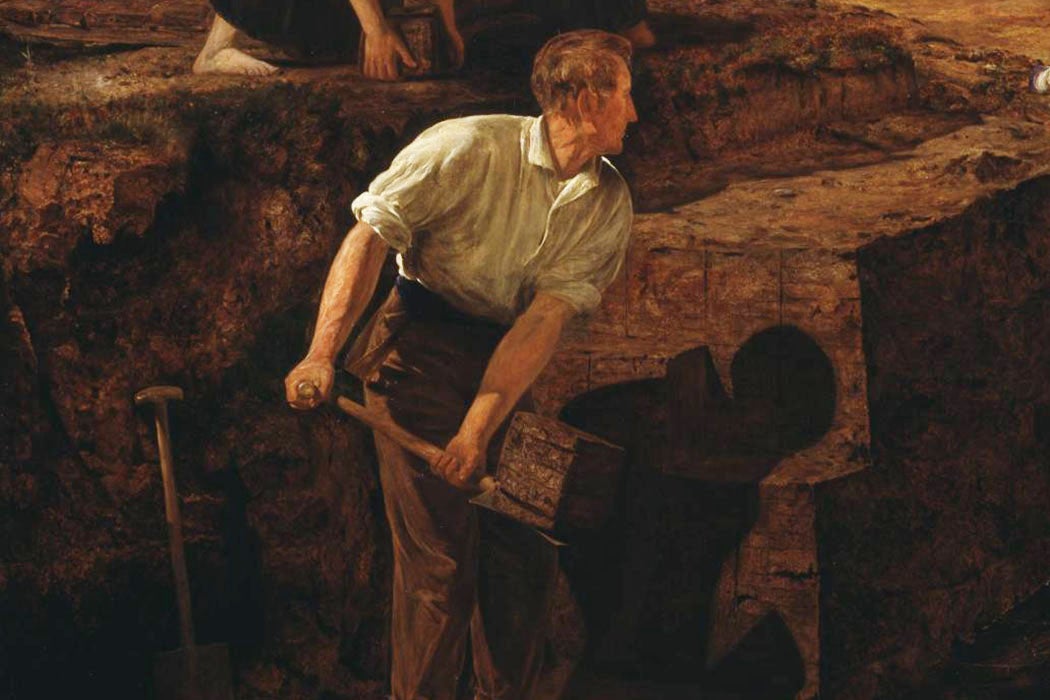Since the nineteenth century, peat (or turf) has brought social consciousness to art in Ireland and England. In the 1800s, early landscape photographs and Pre-Raphaelite paintings focused on the fact that the poor harvested it. From the late twentieth century, photography and sculpture use peat to remind us of our connection to nature. But why?
Ireland has few trees, little coal, and lots of peat. As far back as the eighth century, law-tracts dealt with it. Landowners demanded peat work from tenants starting in the fourteenth century, and cutting turf by hand reached its zenith of 6,000,000 tons in 1926. In parts of England like Lancashire, the poor had the legal right to cut turf for fuel (“turbary”). Harvesting peat was linked to the poor in both cases.
April to August were peat extraction and drying months. Harvesters entered moors and bogs, removed the top layer of earth and cut rectangles of the deeper, more compact peat. They stacked these rectangular “sods” in pyramids to dry, rearranging them throughout the summer. From autumn, they burned them for fuel. The work was tiring. Post-harvesting, the landscape was barren.
It is easy to understand why nineteenth century landscape photos of peat depict poverty and barrenness. Harvesters are bent, their clothes are dirty, and they are surrounded by dark pits. These photographs are a silent commentary on nineteenth-century rural poor, as are turf paintings by Thomas Wade, a Pre-Raphaelite painter from Lancashire.
Pre-Raphaelites, inspired by the style of late medieval and early Renaissance art before the arrival of Raphael, often chose to address difficult subjects. They tackled issues like poverty and painted religious figures with more realism than their contemporaries. By painting turf cutting, Wade showed his understanding of his surroundings and his attachment to the Pre-Raphaelites.
For Heather Birchell, who wrote an introductory book on the Pre-Raphaelites, Wade “was at his most Pre-Raphaelite” in his painting “Cutting Turf from Farington Moss.” The exhausted family and donkey are religiously symbolic of Mary and Joseph’s flight from Egypt. Behind them, the dark, harvested land is an open wound in the lush countryside. And they are fleeing it.
In “Turf Cutters“, Wade paints the family as a pyramid structure, from the head of the girl to the dog drinking from the stream to the empty metal container bottom left. This symbolizes the pyramids of drying peat sods. Wade painted turf to show the rural poor struggling to survive.
But today, instead of the rural poor, huge machines undertake large-scale turf harvesting for fuel. In art, peat now represents a fragile, natural landscape (it grows at only about 1mm per year). Peatlands are rare places where people can find openness and reflection. Contemporary photographs and sculpture invite people to feel protective not just of turf, but of the landscape it creates.
In 2008, Ruairí Ó Cuív and Kevin O’Dwyer curated an exposition entitled Peatlands in Aras an Chontae in Tullamore, Ireland, to coincide with the annual International Peat Congress. Environmental artists like Marianne Jørgensen and Alan Counihan created sculptures and photographs with peat in a cut away bog called Lough Boora. It is now one of the most celebrated sculpture parks in Europe. Rather than going into the peatlands to labor to cut it, people now walk in peatlands to feel a connection to nature.







